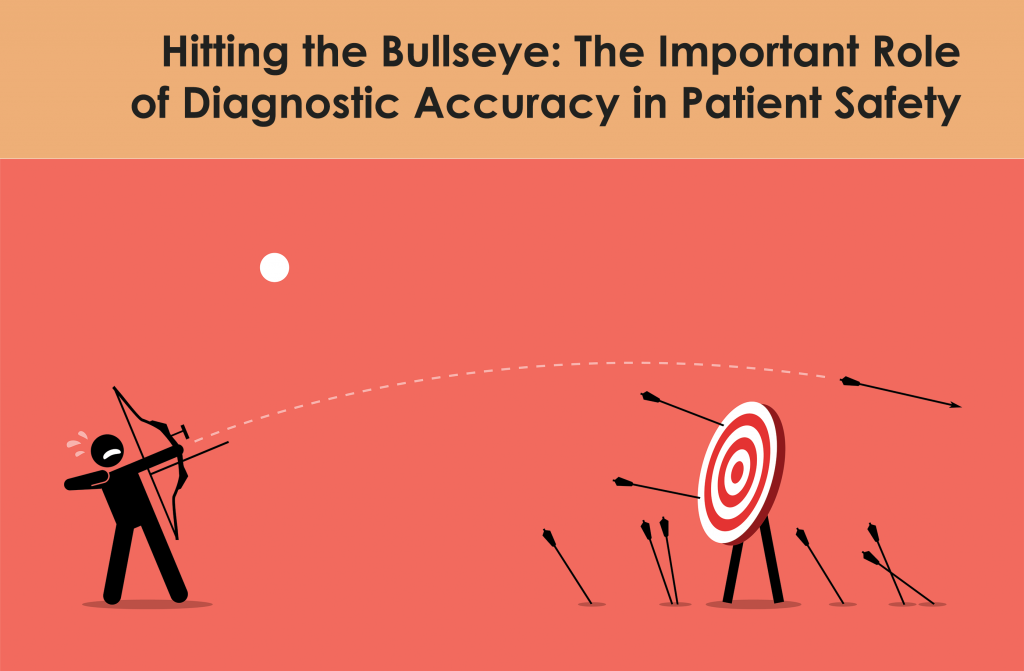- FHCQ Foundation for Health Care Quality
- COAP Care Outcomes Assessment Program
- Spine COAP Care Outcomes Assessment Program
- SCOAP Care Outcomes Assessment Program
- OBCOAP Care Outcomes Assessment Program
- CBDR
- Smooth Transitions
- WPSC Patient Safety Coalition
- Bree Collaborative Bree Collaborative
- Health Equity Health Equity
- Admin Simp
- Contact Us
HITTING THE BULLSEYE: THE IMPORTANT ROLE OF DIAGNOSTIC ACCURACY IN PATIENT SAFETY

HITTING THE BULLSEYE: THE IMPORTANT ROLE OF DIAGNOSTIC ACCURACY IN PATIENT SAFETY
by Karen M. Markwith RN, MJ, CPHRM, CHPS | Director of Quality and Patient Safety, Virginia Mason
In our January 2018 strategic planning session, diagnostic error rose to the top of the discussion and became one of the two key areas we voted to devote WPSC efforts to this year, the other being patient safety culture. To that end, we’ve split our Action Planning Subcommittee into two groups: Diagnostic Error and Patient Safety Culture, in an effort to divide and conquer. Below, Karen Markwith of Virginia Mason, one of the members of the Diagnostic Error group chaired by Randy Moseley, explains the importance of diagnostic accuracy as it pertains to patient safety and why we’ve chosen it as a focus.
There are two decisions you need to make when first taking up archery: Which type of archery are you interested in, and which bow will work best for you? These two decisions will provide you with an increased chance of accuracy in hitting the target or bullseye. The goal of accurately diagnosing a patient’s condition is similar to an archer’s goal of hitting the bullseye.
The Institute of Medicine’s (IOM) committee’s definition of diagnostic error is as follows: The failure to (a) establish an accurate and timely explanation of the patient’s health problem(s) or (b) communicate that explanation to the patient (NAS).
Unfortunately the lack of an accurate diagnosis is more common than we realize and can result and serious harm; even death.
WHAT THE RESEARCH SAYS
Using varied methodologies, studies have found the following:
- Major diagnostic errors that may have contributed to the patient death have been detected in 10% of autopsies[1]
- In hospitals, an estimated 7%-17% of adverse events result from diagnostic errors, based on studies of retrospective record reviews[2]
- At least 1 in 20 adults experiences a diagnostic error each year, based on studies in U.S. outpatient settings[3]
- Inaccurate or delayed diagnoses can also have repercussions beyond a single episode of care and cause ripple effects in the form of inaccurate treatment plans, adverse health events, and psychological and financial consequences.
TARGETS TO AIM TOWARD
The IOM published a report in 2015 on diagnostic errors and the need to improve diagnosis.[4] According to the report, to improve diagnosis is a “moral, professional, and public health imperative.” The report identified eight overarching goals and many supporting recommendations. I am not going to go in-depth on each goal but provide some perspective on a few that could be considered reasonable suggestions.
Eight Goals Outlined in the IOM Report
- Teamwork among healthcare professionals, patients and families
- Education and training regarding the diagnostic process
- Supportive health IT systems
- Identification of errors and near misses and efforts to learn from and reduce them
- A supportive culture and work system
- Learning-focused reporting and medical liability systems
- Supportive payment and care delivery environments
- Research funding
STRENGTH IN NUMBERS
The focus on teamwork among healthcare professionals, patients and families and the improvement of communication is pivotal to improving accuracy in the diagnostic process. Communication among all members of the team must be timely and effective as well as clearly documented in the medical record, according to the IOM report. To improve teamwork, the breaking of silos and paradigms among members of the diagnostic team is also an innovative step in increasing accuracy. For example, integrating laboratory staff into assisting with what type of test should be run could assist a clinician when unsure of which tests are best suited to the clinical problem or how to interpret results. Contributions from other healthcare professionals can be value-added to improve the diagnostic process through their monitoring of the patient condition and the sharing of observations concerning the patient’s response to treatment.
ACCOUNTING FOR BIAS: THE WIND FACTOR OF DIAGNOSIS
Obtaining a variety of information also helps support the reduction of inherent bias, or what is often referred to as cognitive bias, that can contribute to an inaccurate diagnosis as well. Cognitive biases are a universal feature of human cognition like system errors for the brain. Understanding the contribution of cognitive bias and the interaction of bias with system errors and how they may produce bad outcomes should be part of the education and training regarding the improvement of accuracy in the diagnostic process. According to Graber et al (2015), when conceptualizing cognitive error whenever a patient is harmed in relation to the diagnostic process, two broad categories of causal factors should be considered:[5]
1) The “Blunt End” — All the system-related elements that contribute to diagnosis.
2) The “Sharp End” — All the cognitive factors.
Cognitive bias also can produce anchoring, which is the tendency to rely too heavily on the initial piece of information offered when making decisions. In this case, we risk starting from an initial impression and failing to adjust appropriately. The concept of anchoring when applied to the diagnostic process is the tendency to perceptually lock on salient features in the patient’s initial presentation too early in the diagnostic process, and fail to adjust this initial impression in light of later information.
Common “anchors” that can contribute to an inaccurate diagnosis:
- Billing codes
- Reason for consultation
- Problem lists
- Previous admissions
- Old diagnosis-new problem
- Previous provider notes
These are just a few examples of what could easily be a longer list. The key component is awareness of the concept of “anchoring” and ensuring that these cognitive biases do not contribute to a diagnostic error.
LEARNING FROM ERRORS AND NEAR MISSES
An example of the #4 goal — identification of errors and near misses and efforts to learn from and reduce them — is understanding the value of a near miss. Near misses are the best signal that something is not right and needs some dedicated attention before the error reaches the patient. One of the most latent near misses that needs a more rigors process is how a clinician addresses “missed labs” by the patient as well as lab results that are narrowly missing the high or low parameters of the diagnostic test. Paying attention to near misses and using them as “teaching moments” can help redesign work systems that support team member involved in the diagnostic process.
Just as the right tools for archery can increase the likelihood of reaching the target, the right goals can help clinicians increase their accuracy with patient diagnosis. As a patient, I want my healthcare professionals to hit the bullseye every time!
ABOUT THE AUTHOR
 Karen Markwith, RN, MJ, CPHRM, CHPS is the Director of Quality and Patient Safety at Virginia Mason Medical Center. Experience includes Regional Director of Enterprise Risk Management for a large health system with multi-state responsibilities. Director of Risk Services for a multi-hospital system and Director of Provider Services for a large medical group. Received graduate degree in Master of Jurisprudence in Health Law from Loyola Law School in Chicago and undergraduate degree in Bachelor of Science in Nursing from Pacific Lutheran University. Co-authored ASHRM 2016 Physician Office Risk Management Playbook as well as the 2017 Healthcare Risk Management Fundamentals manual.
Karen Markwith, RN, MJ, CPHRM, CHPS is the Director of Quality and Patient Safety at Virginia Mason Medical Center. Experience includes Regional Director of Enterprise Risk Management for a large health system with multi-state responsibilities. Director of Risk Services for a multi-hospital system and Director of Provider Services for a large medical group. Received graduate degree in Master of Jurisprudence in Health Law from Loyola Law School in Chicago and undergraduate degree in Bachelor of Science in Nursing from Pacific Lutheran University. Co-authored ASHRM 2016 Physician Office Risk Management Playbook as well as the 2017 Healthcare Risk Management Fundamentals manual.
WORKS CITED
[1] Shojania, K.G., Burton, E.C., McDonald, K.M. & Goldman, L. (2003). Changes in rates of autopsydetected diagnostic errors over time: A systematic review. JAMA, 289:2849-2856.
[2] Leape, L.L., Brennan, T.A. & Laird, N. (1991). The nature of adverse events in hospitalized patients. Results of the Harvard Medical Practice Study II. New England Journal of Medicine, 324, 377-84.
[3] Singh, H., Meyer, A., & Thomas, E. (2014). The frequency of diagnostic errors in outpatient care: estimations from three large observational studies involving US adult populations. BMJ Quality & Safety, 23(9), 727-731.
[4] National Academies of Sciences, Engineering, and Medicine. 2015. Improving diagnosis in health care. Washington, DC: The National Academies Press.
[5] Graber, M.L., Reilly, J.B., Trowbridge, R.L. (2015). How to do a root cause analysis of diagnostic error. Patient Safety Awareness Week webcast. National Patient Safety Foundation. https://pdfs.semanticscholar.org/presentation/d4f5/ad7772573a8a3e3d7d5e4808303ace42bf4d.pdf
Recent Posts
- TakeCharge This Patient Safety Awareness Week: 5 Steps to Safer Healthcare
- Stigma & Bias in Healthcare: The Obstacles, Consequences and Changes Needed
- Agility in Crisis: How The Everett Clinic responded to COVID-19
- Collaboration over Competition: How Pediatric Hospitals Can Thrive When They Work Together
- Reducing Stress for Health Professionals During the COVID-19 Pandemic


